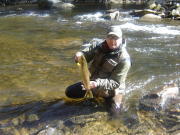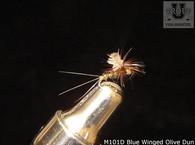Since we have been having a major winter here in the Smoky Mountains with a great deal of snow fall and with unseasonably cold weather, it may be time to discuss the water temperature and how it affects the trout fishing. We have discussed this in some length in Class 2052 Winter Trout Fishing by Dan Farnsworth who is from the very far North and who will not go fishing in the summer.
How Water Temperature Affects Trout:
Trout are cold blooded creatures and their body temperature is the same as the water temperature and unlike humans, they do not feel cold or warm. For humans the “normal” body temperature is 98.6 degrees and we feel cold when the air temperature is freezing. The trout’s metabolism is however affected by the water temperature and slows down as the water cools down. In cold water, they move about much less than they do in ideal water temperatures of 55 to 60 degrees. In warm water, their metabolism is high and they need to eat a lot to maintain their body weight or grow in weight. They will need to position themselves in faster or moderately moving water. where they can get the maximum amount of food with the least amount of energy.
Cold water on the other hand will contain a greater amount of dissolved oxygen and the water does not need to be moving to pick up more oxygen. Therefore, the trout can live well in the still or slower moving areas of the stream making it unnecessary to spend energy fighting the fast water. Another point to consider; if the water is flowing at five miles an hour and the trout are in the fast water, they must swim at five miles per hour just to keep from being carried downstream.
How Changing Water Temperature Affects Trout:
Changes in water temperature affect the feeding habits of the trout more than the actual water temperature. When water temperature suddenly changes from an ideal temperature to a colder temperature as it may during a freezing rain or hail storm, it will slow down the feeding habits of the trout until they adjust. This may take one day or more to occur and in the meantime they will definitely be in the slower water. In the Smokies we have often been successful when there was snow on the ground and even when it was snowing. The falling snow will not affect the water temperature as much as it will affect the angler. Also, contrary to what some anglers believe, they are not going to be in the sunny spots of the streams. Since the water in most Smoky Mountains streams is moving rapidly, the temperature of the water is not going to change in those small areas of sunlight.
Locating Trout in cold Weather:
What I am trying to point out is that it is very possible to fish when the water temperature is 40 degrees or even as low as 35 degrees. To locate the fish, ideally, you need to slow down and catching trout will be a little more difficult. Trout can be found in the slow moving water of pools or areas of water near the faster moving water. But you must be careful in identifying the slow moving waters in a stream. Finding the slow moving waters can indeed be deceptive. The slow water can be easily seen from the surface in eddies, etc., however, there are also many areas of the stream beneath fast moving water where the water is moving slow.
A large boulder or series of rocks can create an eddy effect beneath the surface and it is not easily spotted. Of course, there will be cover and slower moving waters near obstructions like brush or logs and also near some banks. Don’t expect to find the trout feeding in runs, but the water under the runs may be moving slower and they may hang there.
Water depth especially in pools will be a factor and the trout will in many cases position themselves near or on the bottom, where the water is barely moving. As a result you will often find the trout in clear, cold water appear to be lying on the bottom. However, these trout in the clear, slow moving waters can see you easily. Trout near the surface have a very small window of vision while the trout holding in deep, clear water have a very large window of vision and can detect objects above the surface much easier and much farther from them. Also, since the water is moving slowly and carrying the fly much more slowly, the trout have a much better look at it and can be far more selective.
Next, we will discuss the best equipment, flies and methods for winter trout fishing.






